A sense of community is alive in the tri-county town of Hoven, S.D.
“Volunteerism is what built this community,” said Vern Rausch, a local rancher.
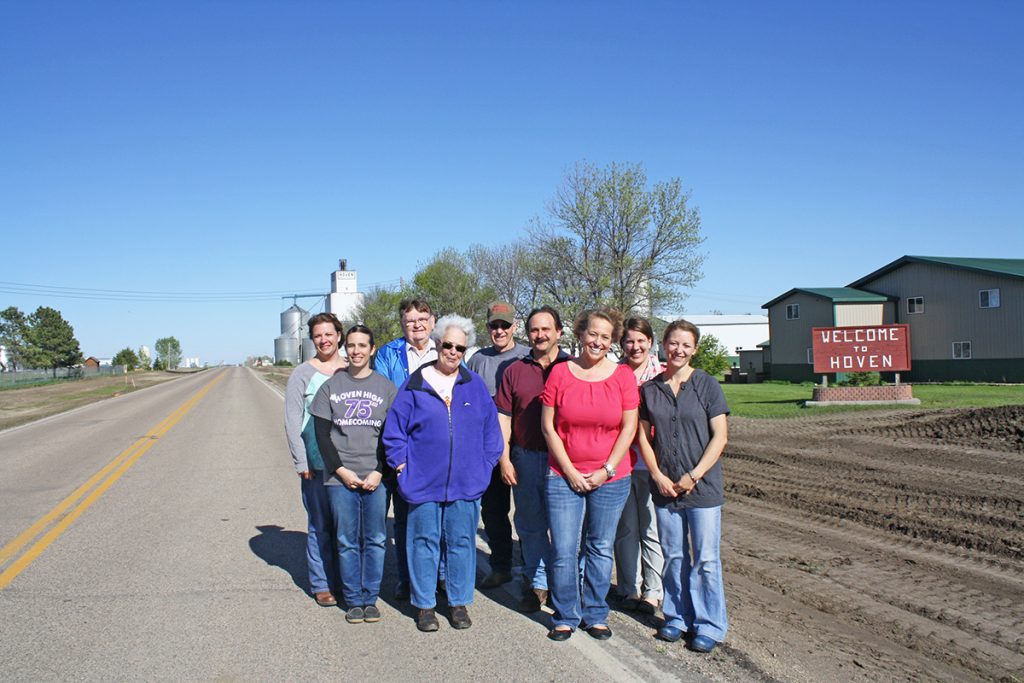
The community of Hoven, S.D., is “Harvesting Hoven’s Potential” through the work of a community survey and subsequent community initiatives. Leaders of the group’s five initiatives—housing, health care, business, youth and day care—gathered recently to talk about the vision they and others have for the future. They included (back row, left to right) Kim Hoerner, Tom Garrity, Vern Rausch, Kevin Hageman, Sara Colombe, (front row) Sara Johnson, Gloria Duenwald, LaDeen Krueger and Krystal Stuwe. By Wendy Royston/Dakotafire Media
Rausch, who is among a handful of people who could be called “Mr. Hoven” because of his involvement and interest in so many facets of the community’s livelihood, said volunteerism has been necessary to keep up all of the amenities built over nearly a century.
“The first thing that very first priest did when he came was that he went around with his horse and buggy and he built a four-story, great big, square, boardinghouse,” Rausch said of the Rev. Anthony Helmbrecht, who is credited as being the mastermind behind the parochial school that provided the only primary education in town until 2000, followed by the “Cathedral on the Prairie,” which draws visitors from around the nation and the globe, and then Holy Infant Hospital, which closed in 2010. “Once you get them, it takes a lot of volunteer work to keep them up.”
The American Legion, the hospital, the schools and the Catholic school all have had organizations such as the Legion Auxiliary or the PTA that supported their efforts.
But all that work is what keeps the cost of living in rural America lower.
“People put their own chairs away,” he said. You don’t hire that done. … That’s why things can be done cheaper in a small town.”
And that’s why, he said, the community that has shrunk from a population of 511 in 2000 to 406 in 2010 has recently rallied to “harvest Hoven’s potential” through an organization with that name focusing on housing, health care, businesses, youth and day care—and why he’s confident its efforts will make a difference for Hoven’s future.
“All we need is a group to identify the needs, and then everyone else will follow,” he said. “That’s a characteristic of our community.”
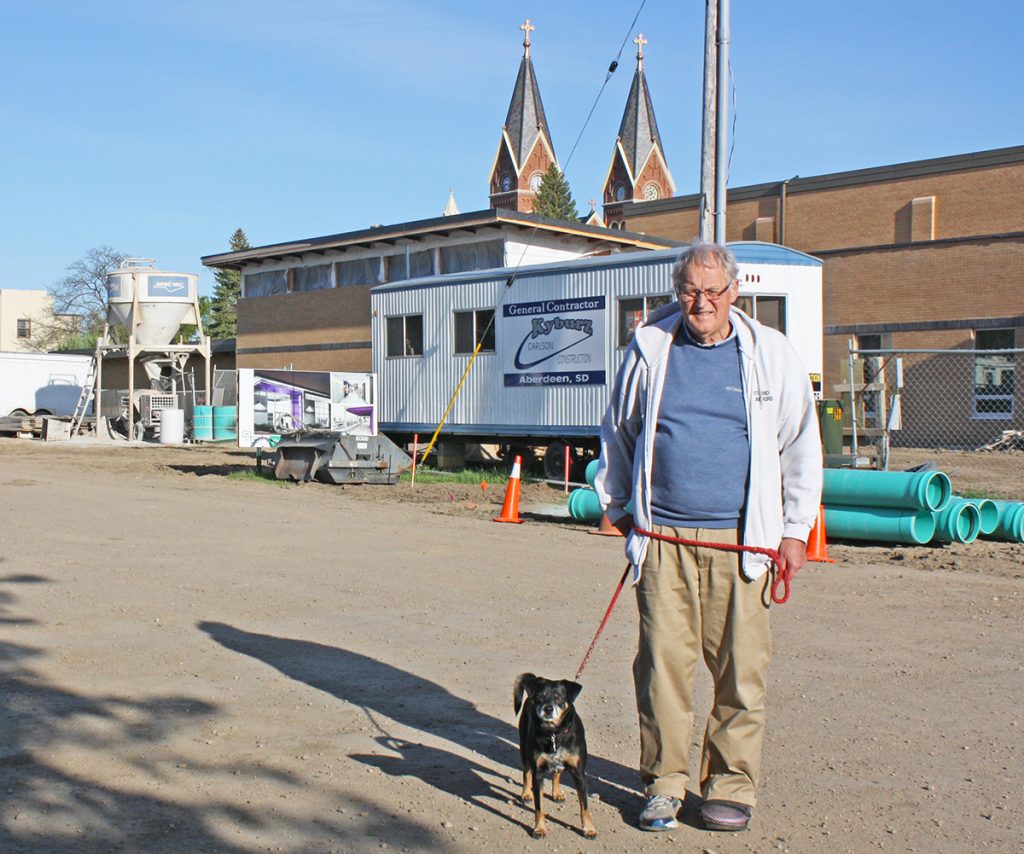
Superintendent Bob Graham and Buddy moved to Hoven, S.D., a year after the high school burned down. Twice retired, Graham said he envisions spending a few more years at work, helping students and staff adjust to the new building, set to open in August, before retiring for good. Buddy is an unofficial service dog to students experiencing medical, emotional or behavioral turmoil during the day.
By Wendy Royston/Dakotafire Media
A future afire from yesteryear’s blaze
When the community’s 74-year-old high school burned down due to an electrical malfunction over Memorial Day weekend two years ago, the town immediately rallied, unwilling to let its future go down in flames.
“People were gathered on the streets,” Rausch said, his voice thick with emotion, “and people were sticking money in my pocket, and they said, ‘We want to help. We want this back.’”
From those initial dollars, a fund was started for items not covered by the district’s insurance policy.
Because school had just let out for the year—graduation ceremonies had been held the weekend before—staff had just inventoried every computer, desk, book and pencil in the facility. Though those lists were destroyed by the fire that started in the attic of the unoccupied building, they were more easily reconstructed because they were fresh on employees’ minds, according to school secretary Kim Hoerner.
“We’ve got more than we thought we would have—way more,” Hoerner said. “But there are still things we realize we’re missing every day.”
The past two years, Hoven High School students and staff have reported to the Holy Infant Hospital building, which had closed four years prior, due to financial hardship. That timing is more than a coincidence, according to locals.
“It was kind of a blessing in disguise” that the hospital had closed prior to the fire, said Mark Weber, president of the Hoven School Board. “We sent our people over there to start cleaning it up, and it was a good fit. It wasn’t perfect, but nothing is going to be perfect.”
In fact, the town, consisting of nearly all Catholics—it is said that maybe a handful of families practice any other faith—believes the fire was actually a gift.
“The good Lord burned that school down for us,” Rausch said. “Because all the neighboring towns are building new schools, five years from now, or 10 years from now, we’d have had the old school (and) the kids would have gone to all of those new schools. Now, we are going to have the new school, and the insurance is paying for it, whereas the other districts have struggled to make theirs work.”
The $5.1 million project, covered mostly by insurance, includes new administration offices, cafeteria, concessions stand and school-community wellness center, plus adds climate control and a sprinkler system to the elementary school. It is set to open this fall, putting the elementary and high school students on the same campus for the first time.
Still, “building a new, multimillion-dollar school” with just 118 students, “you’ve got to have some optimism,” Rausch said. “We just dodged a bullet.”
“We’re pretty proud of what we have, and we want to keep it,” Weber agreed. “We can’t lose our school, because if we do, pretty soon, the tumbleweeds are going down Main Street, and our businesses are very important too. … We know in Hoven that, if you lose your school, you lose more than you can imagine. Most of the social events surround the school”—especially during the winter.
And, in Hoven, support for the school has been primarily a private endeavor for many years. Until 2000, the only elementary school in town was St. Anthony’s Catholic Elementary, where families from Hoven and elsewhere paid $200 tuition annually. The public school purchased that building, and for the first time offered public elementary education.
“It was a tough, tough deal,” according to Weber, who spent his own early education with the Catholic sisters, “but it turned out all right.”
Still, most of the funds for the school district come from local contributions. The Hoven School District is one of just a few in the state for which the state education aid program does not apply, because the local tax base generates enough money, according to state guidelines, to adequately fund education, based on local enrollment. The district currently has two opt-outs on its tax rolls to help carry that burden, and the recent change in school funding “kind of puts a pinch on things” more than ever before, according to Weber, because the state did away with a separate fund for teacher pensions, from which Hoven could draw.

Quality emergency care has become even more critical in Hoven, S.D., than it once was, since the 2010 closure of Holy Infant Hospital (in the background). The city council’s progressive emergency services program has kept the town that now is 25 miles from the nearest hospital alive with emergency medical technicians, emergency vehicle operators, and now paramedics. Paramedic Brady Hartung, EMT Kurt Rausch, EMT Blair Ruckman, Paramedic Jill Cody, and EMT Anna Marshall all are members of the Hoven Ambulance crew. By Wendy Royston/Dakotafire Media
A health care evolution
While the closure of Hoven’s 67-year-old Holy Infant Hospital and Hoven Medical Clinic in 2010 was seen as a blow to the community, a part-time chiropractor has made it his mission to see that the community’s wishes are honored in regard to access to local health care.
“The Hoven community is very persistent in their hopes of acquiring primary care. They’ve done multiple surveys, and having a primary care clinic—preferably with lab and X-ray—always seems to be at the higher priority … wish list for the community,” said Dr. Nathan Kadlec, who began practicing two half-days per week from within Holy Infant Hospital in 2009.
He continues to practice there now that the building houses the temporary high school, but he is purchasing a building on Main Street, which he plans to extensively remodel, with the plan to move in around the time school opens for the year. But he hopes not to be there alone.
Kadlec is working to recruit a primary care provider to share the space with him, and plans to remodel the building to suit the needs of the provider or group that sees Hoven as a good fit. He hopes to have the medical provider(s) found and ready to work within a year.
The chiropractor said communities like Hoven and Ipswich are his passion.
“I’m pursuing this not just for the betterment of myself, but also for my patients and that community,” he said.
So far, no plans are in place for the three-story hospital building. There is talk about industry or hospitality, but the community knows the iconic building constructed during World War II soon may no longer take up half a block of Main Street.
Prepared for emergencies
The city of Hoven laid groundwork in 2011 to keep emergency medical services flourishing in the town into the future.
Jill Cody and Brady Hartung approached the Hoven City Council, asking whether they would add paramedics to the city’s ambulance service. The city agreed to the request, paying $25,000 for each to be educated, in exchange for a five-year, rotating-weeks call contract to the city, plus $50 per day for call pay and $18.50 per hour when they’re on a run.
Francis Karst, a Hoven City Council member who served on the ambulance crew himself, said that, while paying ambulance workers isn’t necessarily the norm in rural communities, it’s important. Plus, it’s an incentive to giving up the hours it takes to earn the certifications necessary to then give up the time to respond to the calls and drive 20 minutes or more to get to a neighboring hospital.
“It’s a long way to the hospital, and everybody’s got friends and neighbors that get into a car wreck or (have a medical emergency) and they need help,” he said. At one point, the EMT rolls dipped to eight, but there’s always been someone willing to step up to help. “We’d start a new EMT class, and everybody would talk to somebody. I’d always say … ‘You might save your kids from choking with the Heimlich maneuver, or with a broken arm/broken leg, you’d know what to look for. Take the course! It’s free! The city’s going to pay for … the knowledge you’re going to gain out of it.”
The city pays all three of its on-call emergency personnel—an EMT (paid $175 per week for call, and $15 per hour for a run); a registered nurse ($175 per week, plus $18.50 per hour) and a driver ($100 per week, plus $10 per hour). It’s a system that has worked to keep the service staffed, and the communities of Hoven, Tolstoy, Caska and Lebanon covered by two ambulances.

Rural communities must invest today in the services that the community will need tomorrow, in order to have any hope of surviving outmigration to larger cities, according to Hoven, S.D., Mayor Jack Feldmeier and council member Francis Karst. By Wendy Royston/Dakotafire Media
Investments
The city of Hoven is investing millions of dollars into several projects to upgrade the community for future residents.
“If you don’t keep up the water, the sewer and everything else, eventually it’s not going to work,” and the community will continue to shrink, according to Mayor Jack Feldmeier.
This summer’s project include a shared Main Street-Highway 47/20 reconstruction project, and an upgrade to the city’s sewer and water lines. With the high school construction also happening at the end of Main Street, Hoven is getting a major facelift, and construction is a major topic of discussion.
“Eighty-five percent (of the population) is elderly people, and they’re going to need help,” Karst said, so it’s important to not just keep the people who already live in Hoven there, but also bring in younger folks. “The farming communities have been making money to beat heck the last five to 10 years, and we’re hoping that the next-generation sons will take over, the parents will move to town and build houses. If we keep all of the commodities here,” Hoven should be a welcoming place for all generations to live.
Harvesting Hoven’s Potential’s housing initiative team is working to ensure that housing options in town match the desires of the people wanting to move in to work there.
“We do seem to have a shortage of housing in the area in order to grow and bring in people who can help the community expand and have longevity to it,” said Kevin Hageman, chair of the housing initiative team. “There’s certainly workforce housing, adequate to raise families in … (though) there are certain amenities that maybe people would like to have that aren’t there.”
Some of the 40 employees at Associated Milk Producers, Inc., where Hageman is manager, drive as far as 50 miles to get to work.
“They’re willing to drive, but if they found something adequate here, they would come here, so we’re trying to secure some of that housing,” Hageman said, adding that, once employees settle in another community, it’s harder to move them to town. “They get their families established, (and) they plant roots there.”
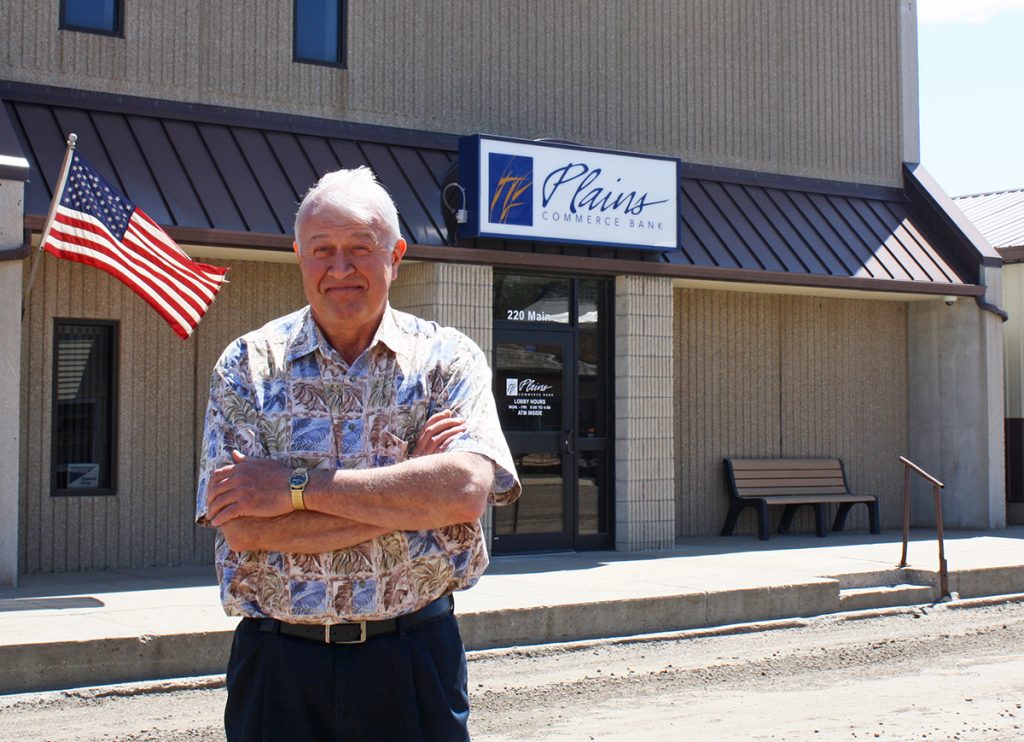
Plains Commerce Bank, which began as Bank of Hoven, S.D., more than 80 years ago, continues to house its main office in Hoven, because “we grew up from our roots here,” according to Executive Vice President and Branch Manager Chuck Simon. By Wendy Royston/Dakotafire Media
Harvesting Hoven’s Potential
Those with roots in Hoven know the potential of the community.
“Some of us are old enough to remember when we had good times and things were flourishing,” Rausch said. The loss of the hospital was “like a death to the community, because there were so many jobs we lost. It was a domino effect: It took the pressure off the drugstore, we eventually lost the drugstore, and it was just one thing after another happening. Then, the school burned down. So it is time to do something.”
The group said the future of Hoven lies in its youth, so members are committed to investing in the amenities that tie kids to communities.
“We can’t do anything in this community without the youth,” Rausch said. “I don’t care whether we put on a Christmas concert or what we do. We have them do the hard work—carry the chairs and serve the tables. … They all learn to work together like a big family—the older ones take care of the younger ones, and they all learn to share.”
That’s a characteristic not found in the youth of all small communities.
“The kids here in Hoven are very much givers,” said Krystal Stuwe, who recently moved her own family of 10 to town from a neighboring community. “They have been taught well. … I think it’s just something that has been given to these kids—that’s been (modeled) to them.”
Though the youth population of Hoven is small, the community group is working to increase recreation opportunities. The pool is maintained and run mostly by a committee of parents, with a $25,000 annual contribution from the city. An after-school physical education/mentoring program, jump rope and 4-H all are among the considerations for youth engagement that are being considered based on community survey results.
“So much of what people wanted was involved in 4-H, so we didn’t want to reinvent the wheel,” Stuwe said. “We drive so much, as parents. It’s exhausting. That (sports cooperative with Gettysburg) is a good thing for us, but, man, everybody is tired. It draws so much out of our community that, to drive one more day, or to do one more thing, it’s just hard.”
With too few young girls to have a softball team, a coed baseball team has been created, and it plays against teams from other towns—most of which are all-boy teams. Over age 12, ballplayers head to Gettysburg for teener ball, but Hoven is looking to form its own team in the future.
“For now, this is what works,” said LaDeen Krueger, head of the youth initiative team. “And it’s not just about sports—it’s about keeping them active and something to do.”
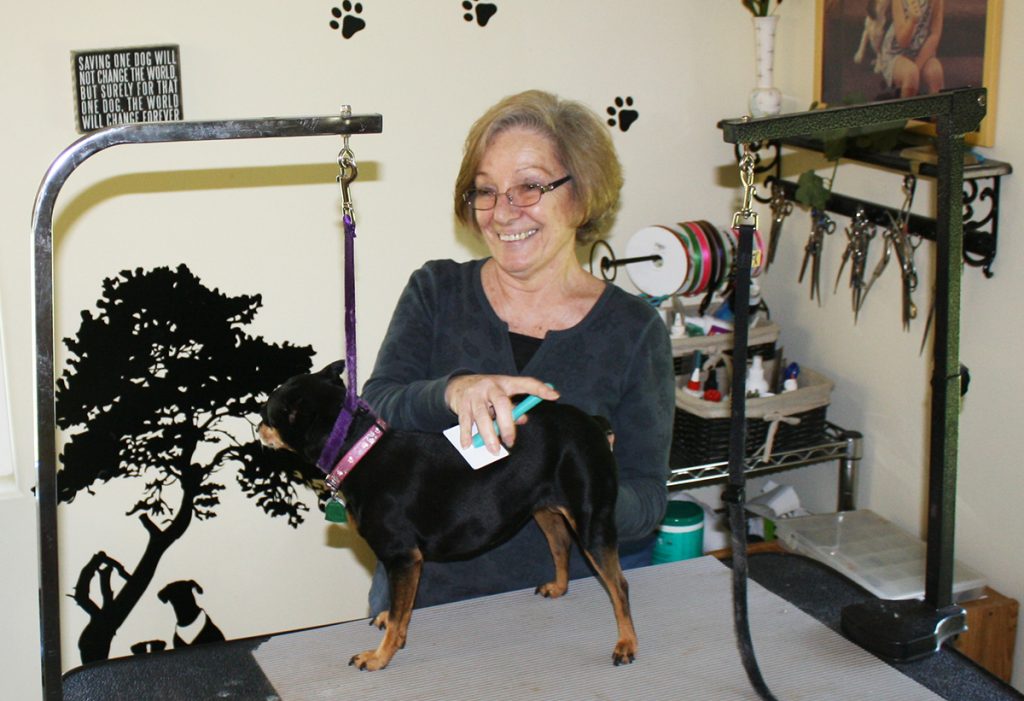
Faith Thorne, who worked as a dog groomer in Chicago until moving to Hoven, S.D., three years ago, said she enjoys the slower pace of rural America, but has no shortage of work, because dog grooming appointments are hot commodities in the area.
By Wendy Royston/Dakotafire Media
Finding a niche
Since 2014, Hoven has had the luxury of a service that at one time was unheard of in rural communities. Faith Thorne, a master groomer with 26 years of experience cleaning and trimming dogs, cats, rabbits, lambs and gerbils, moved to Hoven from Chicago with her husband, to be closer to his Gettysburg family.
The couple built a new building on Main Street, and Thorne has found herself comfortably busy at Precious Pets.
Aberdeen groomers are booked two to three months in advance, so she keeps a stack of business cards in their clinics, and they refer clients to her routinely.
“I’m glad I’m not that busy, because if they call in the morning, I know that what they really want is to get their dog done that day,” Thorne said.
Even when a second groomer opened up shop on Main Street almost simultaneously to Precious Pets, Thorne kept busy. Now, that groomer has closed, and others are opening in neighboring communities.
“It’s nice working alone,” she said, after she “spent more time fixing problems” than working with animals when she employed four groomers, a bather and a brusher in Peoria, Ill.
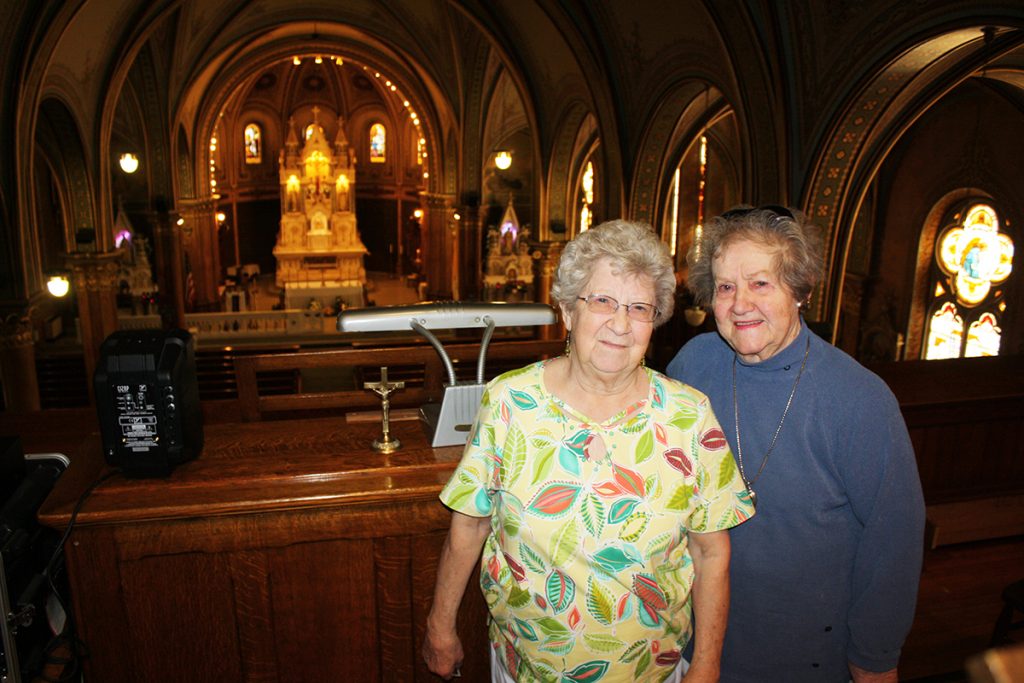
Sisters Alice Simon, left, and RoseMarie Reuer have celebrated family and community milestones in St. Anthony of Padua Catholic Church for six generations. They and deceased sister Agnes Reuer have proudly hosted numerous tours of the “Cathedral on the Prairie.” By Wendy Roston/Dakotafire Media
Built by faith, maintained by love
Hoven is known for the expansive, ornate “Cathedral on the Prairie” that sits on Main Street, across from the elementary school, and next to the former Holy Infant Hospital building.
St. Anthony of Padua Catholic Church is the parish home to 230 families in a town said to be 98 percent Catholic. Visitors from around the globe come annually to take in the massive columns and intricate paintings that fill the Bavarian-style structure.
The church was built in the 1920s to replace a smaller, wooden church that had been struck by a tornado. The Bavarian priest at the time, the Rev. Anthony Helmbrecht, “always told us that God, family and education were the three most important things in life,” according to lifelong parishioner RoseMarie Reuer, so a school with boys’ and girls’ dormitories for out-of-towners was built first. Helmbrecht suggested each family contribute $1,000 to the church-building fund, but the 75 families pooled $250,000, and the priest worked with a Bavarian architect who had settled in Wisconsin about the time that he came to Wisconsin from Bavaria to attend seminary.
“I think that’s a little God incident,” Reuer said.
In the 1970s, the walls of the church began peeling, and the plaster was cracking, and contractors were called to evaluate it.
“The first two that came said, ‘Plaster it, paint it, and forget it,’” Reuer said. “We didn’t want to do that, because we remembered our grandparents talking about building this church. The third one came and looked at it.” A third contractor said the work would take seven years to complete. “He wouldn’t sign a contract for ($500,000), because he knew it would be more than that.”
The parish council wasn’t sure how to proceed, but the priest told the congregation they would do the work themselves.
Parishioners set to work, recreating 50 replicas of stencil patterns. A local artist custom-mixed paint to keep the historic details of the church. “God placed (artists) here for a reason,” Reuer said. Another painted the Last Supper engraving on the high altar, which once was plain white marble. In all, the renovation took 20,000 volunteer hours over four years.
Throughout St. Anthony’s history, “God has provided,” according to Reuer and her sister, Alice Simon, who has been an organist for the church for more than 60 years. The untimely death of another sister, Agnes Reuer, 13 years ago even resulted in a sizeable “gift” to the parish.
The two Reuers were scheduled to show two journalists from St. Paul the church, but Agnes, who had returned home from a car accident and subsequent surgery the night before, did not arrive for Mass. RoseMarie was summoned to the hospital, and was disheartened to find that the photographer had followed her.
Just a couple hours after Agnes’s death, she gave the tour anyway, feeling a duty to the out-of-staters.
The following day, a large photograph of her dying sister receiving Last Rites appeared on the front page of the St. Paul Pioneer Press.
A few days later, the blessing arrived, in the form of a letter from a woman in St. Paul who had been touched by the story. And her gift of $80,000 happened to be exactly what was needed to cover the cost of installation of a replacement communion rail at the front of the church.
Reuer said the dedication of the people of Hoven to the church—and the community—and the faith that God constantly provides for the needs of both, is a testament to their Catholic upbringing.
“You learned of so many saints that had tough lives … but they still had such faith in God, and I think that really just resounded with you,” she said.
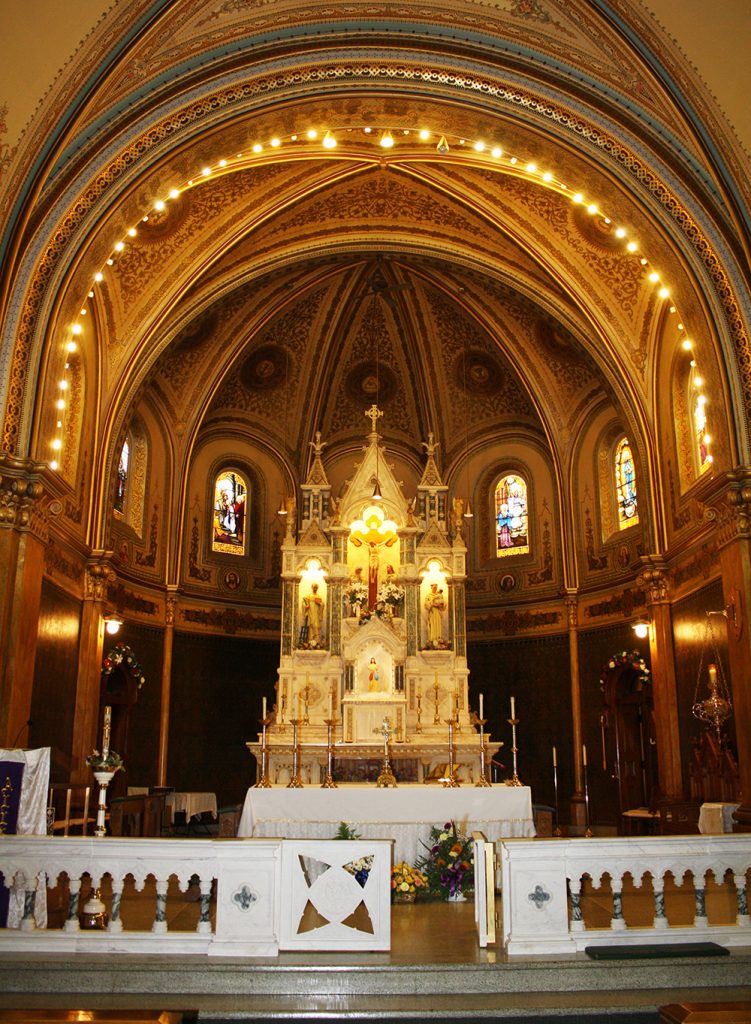
St. Anthony of Padua Catholic Church in Hoven, S.D. Photo by Wendy Royston/Dakotafire Media
 Dakotafire Get your spark here.
Dakotafire Get your spark here.



